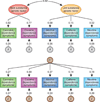Recent advances in the genetic epidemiology and molecular genetics of substance use disorders
- PMID: 22281715
- PMCID: PMC3297622
- DOI: 10.1038/nn.3018
Recent advances in the genetic epidemiology and molecular genetics of substance use disorders
Abstract
This article reviews current advances in the genetics of substance use disorders (SUDs). Both genetic and environmental sources of risk are required to develop a complete picture of SUD etiology. Genetic sources of risk for SUDs are not highly substance specific in their effects. Genetic and environmental risks for SUDs typically do not only add together but also interact with each other over development. Risk gene identification for SUDs has been difficult, with one recent success in identifying nicotinic receptor variants that affect risk for nicotine dependence. The impact of genetic variants on SUD risk will individually be small. Although genetic epidemiologic methods are giving us an increasingly accurate map of broad causal pathways to SUDs, gene discovery will be needed to identify the specific biological systems. Identifying these risk genes and understanding their action will require large clinical samples, and interaction between these studies and work in model organisms.
Figures




References
-
- American Psychiatric Association. Diagnostic and Statistical Manual of Mental Disorders. 4th edn. revised. Washington, DC: 2000.
-
- Kendler KS, Prescott CA. Genes, Environment, and Psychopathology: Understanding the Causes of Psychiatric and Substance Use Disorders. Guilford, New York: 2006.
-
- Goldman D, Oroszi G, Ducci F. The genetics of addictions: uncovering the genes. Nat. Rev. Genet. 2005;6:521–532. - PubMed
-
- Li MD, Cheng R, Ma JZ, Swan GE. A meta-analysis of estimated genetic and environmental effects on smoking behavior in male and female adult twins. Addiction. 2003;98:23–31. - PubMed
Publication types
MeSH terms
Grants and funding
- DA019498/DA/NIDA NIH HHS/United States
- MH084952/MH/NIMH NIH HHS/United States
- R01 DA030005/DA/NIDA NIH HHS/United States
- DA030005/DA/NIDA NIH HHS/United States
- DA023549/DA/NIDA NIH HHS/United States
- K99 DA023549/DA/NIDA NIH HHS/United States
- DA022989/DA/NIDA NIH HHS/United States
- DA027070/DA/NIDA NIH HHS/United States
- P20 AA017828/AA/NIAAA NIH HHS/United States
- R01 DA024413/DA/NIDA NIH HHS/United States
- DA024413/DA/NIDA NIH HHS/United States
- U01 DA024413/DA/NIDA NIH HHS/United States
- DA025109/DA/NIDA NIH HHS/United States
- AA018755/AA/NIAAA NIH HHS/United States
- DA18673/DA/NIDA NIH HHS/United States
- R37 DA018673/DA/NIDA NIH HHS/United States
- AA15416/AA/NIAAA NIH HHS/United States
- R21 DA027070/DA/NIDA NIH HHS/United States
- R01 DA025109/DA/NIDA NIH HHS/United States
- K02 AA018755/AA/NIAAA NIH HHS/United States
- AA011408/AA/NIAAA NIH HHS/United States
- R37 AA011408/AA/NIAAA NIH HHS/United States
- AA017828/AA/NIAAA NIH HHS/United States
- R00 DA023549/DA/NIDA NIH HHS/United States
- K01 DA019498/DA/NIDA NIH HHS/United States
- R01 DA018673/DA/NIDA NIH HHS/United States
- R01 AA015416/AA/NIAAA NIH HHS/United States
- R01 AA011408/AA/NIAAA NIH HHS/United States

